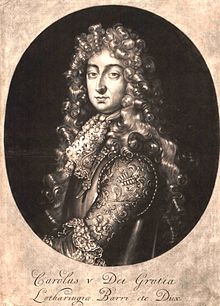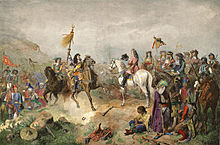| Charles V | |
|---|---|
 | |
| Duke of Lorraine and Bar | |
| Reign | 18 September 1675 – 18 April 1690 |
| Predecessor | Charles IV |
| Successor | Leopold |
| Born | (1643-04-03)3 April 1643 Vienna, Archduchy of Austria, Holy Roman Empire |
| Died | 18 April 1690(1690-04-18) (aged 47) Wels, Archduchy of Austria, Holy Roman Empire |
| Spouse |
Eleonore of Austria (m. 1678) |
| Issue among others… | |
| Father | Nicholas Francis, Duke of Lorraine |
| Mother | Claude-Françoise of Lorraine |
| Military career | |
| Allegiance | Duchy of Lorraine Holy Roman Empire |
| Service | Imperial Army |
| Years of service | 1663–1690 |
| Rank | Generalfeldmarschall (1675) |
| Battles / wars | Austro-Turkish War (1663–64)
Franco-Dutch War (1672–1678)
Great Turkish War (1683–1697)
|
| Awards | Order of the Golden Fleece (1678) |
Charles V, Duke of Lorraine and Bar (French: Charles Léopold Nicolas Sixte; German: Karl V Leopold; 3 April 1643 – 18 April 1690) succeeded his uncle Charles IV, Duke of Lorraine as titular Duke of Lorraine and Bar in 1675; both duchies were occupied by France from 1634 to 1661 and 1670 to 1697.
Born in exile in Vienna, Charles spent his military career in the service of the Habsburg monarchy. He played an important role in the 1683-1696 Turkish War, which reasserted Habsburg power in south-east Europe, and ended his life as an Imperial Field Marshal.
Life

Charles was born on 3 April 1643 in Vienna, second son of Nicholas, younger brother of Charles IV, Duke of Lorraine, and his wife Claude Françoise of Lorraine. In 1634, his father replaced his uncle as Duke; shortly afterwards, France occupied the Duchy of Lorraine and Nicholas went into exile, resigning in favour of his elder brother. The French withdrew in 1661, but invaded again in 1670 and only returned in 1697.
Charles became heir to the Duchy on the death of his elder brother Ferdinand Philippe (1639–1659). In 1678, he married Eleanor of Austria (1653-1697), widow of Michael I, King of Poland; he stood for election twice as King of Poland but was unsuccessful.
They had four children who survived infancy;
- Leopold, Duke of Lorraine (1679–1729)
- Charles Joseph (1680–1715)
- Joseph Emanuel (20 October 1685 – 25 August 1705) died at 19 in battle. Unmarried and without issue.
- François Antoine (8 December 1689 – 25 July 1715) died aged 25, unmarried and without issue.
His grandson, Francis I (1708-1765), became Holy Roman Emperor in 1745.
His cousin Charles Henri, Prince of Vaudémont (1649-1723) was also a talented military commander; he was excluded from the succession as his father's second marriage was not recognised by the Catholic Church.
Career
Charles, who always called himself Carolus, was destined for a career in the church as a younger son. In 1648 he became provost of Saint-Dié and in 1649 abbot of Gorze Abbey. However, the death of his older brother Ferdinand in 1659 made him heir to Lorraine and Bar. He resigned from his church offices and switched to a military career.
Charles was engaged to Marie Jeanne of Savoy but after his uncle was restored as Duke of Lorraine in 1661, he abandoned this marriage and returned to the Imperial court at Vienna. He took up a career in the Imperial Army in 1663, his first major action being Saint Gotthard in 1664, where he served under the Imperial commander, Raimondo Montecuccoli.

When France re-occupied Lorraine in 1670, both Charles and his uncle fought in the Imperial Army during the 1672–1678 Franco-Dutch War. He was wounded at the Battle of Seneffe in 1674 and replaced his uncle in the Rhineland after his death in 1675, taking part in the recapture of Philippsburg in 1676. In recognition of this, he was promoted Generalfeldmarschall in 1676 but was unable to build on these gains, largely due to poor logistics; in the last stages of the war, he was out manoeuvred by de Créquy and suffered minor defeats at Rheinfeld and Ortenbach.
The Treaty of Nijmegen in 1679 confirmed his title as Duke of Lorraine, but France retained the territory and, in 1681, also annexed Strasbourg, capital of Alsace. Charles' prospects of regaining his Duchy seemed increasingly remote and when the Great Turkish War began in 1683, he was appointed Commander of the Imperial army. He was outnumbered by the Ottomans, who were also supported by anti-Habsburg Hungarians known as Kurucs, as well as non-Catholic minorities who opposed Leopold's anti-Protestant policies.
Charles positioned his men outside Vienna, shielding them from the plague epidemic then prevailing in the city; unlike the Ottomans, many of whom died of it. His forces focused on raiding Ottoman camps and protecting resupply convoys to the city, while Pope Innocent XI assembled an alliance to support the Habsburgs. Known as the Holy League and led by John III Sobieski, this force combined with Charles's troops to defeat the besieging army at the Battle of Vienna on 11 September 1683.
In the next few years, the Habsburg army under Charles reconquered Hungary, Slavonia and Transylvania; his first siege of Buda in 1684 ended in defeat but was followed by major victories over the Ottomans at the siege of Buda in 1686 and the second battle of Mohács in 1687. In May 1688, he resigned his military commission in favor of Maximilian II Emanuel, Elector of Bavaria. When the War of the Palatine Succession broke out in September 1688, he returned to command Imperial forces in the Rhineland and reconquered Mainz from the French on 8 September 1689 but fell ill. He initially returned to his family in Innsbruck, but then wanted to travel to Vienna to organize a comprehensive army reform with Emperor Leopold. He died of a pulmonary embolism in Wels on 8 April 1690. He was succeeded by his son Leopold, who was restored as Duke of Lorraine after the 1697 Treaty of Ryswick. He was initially buried in the Jesuit Church in Innsbruck but after the treaty of Ryswick his remains were transferred to the ducal chapel in Church of Saint-François-des-Cordeliers in Nancy, Lorraine.
Ancestry
| Ancestors of Charles V, Duke of Lorraine | |||||||||||||||||||||||||||||||||||||||||||||||||||||||||||||||||||||||||||||||||||||||||||||||||||||||||||||||||||||||||||||||||||||||||||||||||||||||||||||||||||||||||||||||||||||||||||||||||||||||||||||||||||||||||||||||||||||||||||||||||||||||||||||||||||||||||||||||||||||||||
|---|---|---|---|---|---|---|---|---|---|---|---|---|---|---|---|---|---|---|---|---|---|---|---|---|---|---|---|---|---|---|---|---|---|---|---|---|---|---|---|---|---|---|---|---|---|---|---|---|---|---|---|---|---|---|---|---|---|---|---|---|---|---|---|---|---|---|---|---|---|---|---|---|---|---|---|---|---|---|---|---|---|---|---|---|---|---|---|---|---|---|---|---|---|---|---|---|---|---|---|---|---|---|---|---|---|---|---|---|---|---|---|---|---|---|---|---|---|---|---|---|---|---|---|---|---|---|---|---|---|---|---|---|---|---|---|---|---|---|---|---|---|---|---|---|---|---|---|---|---|---|---|---|---|---|---|---|---|---|---|---|---|---|---|---|---|---|---|---|---|---|---|---|---|---|---|---|---|---|---|---|---|---|---|---|---|---|---|---|---|---|---|---|---|---|---|---|---|---|---|---|---|---|---|---|---|---|---|---|---|---|---|---|---|---|---|---|---|---|---|---|---|---|---|---|---|---|---|---|---|---|---|---|---|---|---|---|---|---|---|---|---|---|---|---|---|---|---|---|---|---|---|---|---|---|---|---|---|---|---|---|---|---|---|---|---|---|---|---|---|---|---|---|---|---|---|---|---|---|---|---|---|
| |||||||||||||||||||||||||||||||||||||||||||||||||||||||||||||||||||||||||||||||||||||||||||||||||||||||||||||||||||||||||||||||||||||||||||||||||||||||||||||||||||||||||||||||||||||||||||||||||||||||||||||||||||||||||||||||||||||||||||||||||||||||||||||||||||||||||||||||||||||||||
References
- Stoye, John (2007). The Siege of Vienna: The Last Great Trial Between Cross & Crescent. Pegasus Books. p. 30. ISBN 978-1933648637.
- Orr, Clarissa Campbell (ed), Oresko, Robert (author) (2004). Queenship in Europe 1660–1815: The Role of the Consort. CUP. p. 21. ISBN 978-0521814225.
{{cite book}}:|last1=has generic name (help)CS1 maint: multiple names: authors list (link) - Ingrao, Charles (2000). The Habsburg Monarchy 1618–1815. Cambridge University Press. pp. 28–29. ISBN 978-0521780346.
- Ingrao, Charles p. 36
- De Périni, Hardÿ (1896). Batailles françaises, Volume V. Ernest Flammarion, Paris. pp. 224–225.
- Ingrao, Charles pp. 28–29
- Tucker, Spencer (2010). Battles That Changed History: An Encyclopedia of World Conflict. ABC-CLIO. p. 215. ISBN 978-1598844290.
- Ingrao, Charles pp. 75–76
- Ingrao, Charles p. 71
Sources
- De Périni, Hardÿ (1896). Batailles françaises, Volume V. Ernest Flammarion, Paris.
- Ingrao, Charles (2000). The Habsburg Monarchy 1618–1815. Cambridge University Press. ISBN 978-0521780346.
- Stoye, John (2007). The Siege of Vienna: The Last Great Trial Between Cross & Crescent. Pegasus Books. ISBN 978-1933648637.
- Tucker, Spencer (2010). Battles That Changed History: An Encyclopedia of World Conflict. ABC-CLIO. ISBN 978-1598844290.
External links
- Chisholm, Hugh, ed. (1911). "Charles V. or IV." . Encyclopædia Britannica. Vol. 5 (11th ed.). Cambridge University Press. p. 934.
- Charles V. Duke of Lorraine, Political and military observations, remarks and maxims, of Charles V. late duke of Lorrain, general of the Emperor's forces. From a manuscript left by him, and never printed before.
- Schilb antiquarian
| Regnal titles | ||
|---|---|---|
| Preceded byCharles IV | Duke of Lorraine 1675–1690 |
Succeeded byLeopold |
- 1643 births
- 1690 deaths
- Nobility from Vienna
- Candidates for the Polish elective throne
- Dukes of Lorraine
- Knights of the Golden Fleece
- House of Lorraine
- People of the Great Turkish War
- 17th-century French people
- Generals of the Holy Roman Empire
- Military personnel from Vienna
- German military personnel of the Nine Years' War
- Military personnel of the Franco-Dutch War